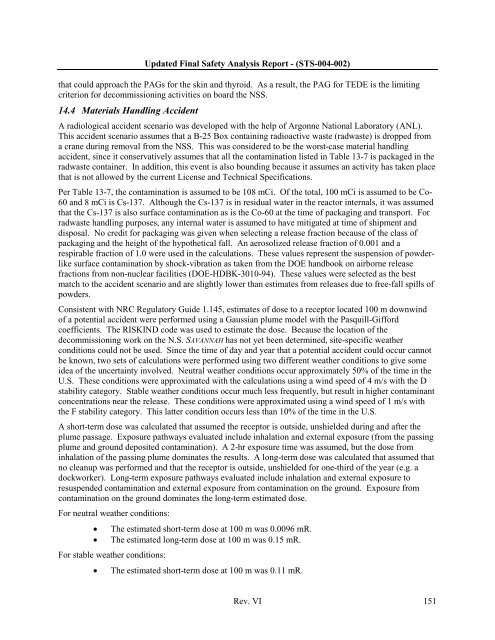10 CFR 50.71(e) - Maritime Administration - U.S. Department of ...
10 CFR 50.71(e) - Maritime Administration - U.S. Department of ...
10 CFR 50.71(e) - Maritime Administration - U.S. Department of ...
You also want an ePaper? Increase the reach of your titles
YUMPU automatically turns print PDFs into web optimized ePapers that Google loves.
Updated Final Safety Analysis Report - (STS-004-002)that could approach the PAGs for the skin and thyroid. As a result, the PAG for TEDE is the limitingcriterion for decommissioning activities on board the NSS.14.4 Materials Handling AccidentA radiological accident scenario was developed with the help <strong>of</strong> Argonne National Laboratory (ANL).This accident scenario assumes that a B-25 Box containing radioactive waste (radwaste) is dropped froma crane during removal from the NSS. This was considered to be the worst-case material handlingaccident, since it conservatively assumes that all the contamination listed in Table 13-7 is packaged in theradwaste container. In addition, this event is also bounding because it assumes an activity has taken placethat is not allowed by the current License and Technical Specifications.Per Table 13-7, the contamination is assumed to be <strong>10</strong>8 mCi. Of the total, <strong>10</strong>0 mCi is assumed to be Co-60 and 8 mCi is Cs-137. Although the Cs-137 is in residual water in the reactor internals, it was assumedthat the Cs-137 is also surface contamination as is the Co-60 at the time <strong>of</strong> packaging and transport. Forradwaste handling purposes, any internal water is assumed to have mitigated at time <strong>of</strong> shipment anddisposal. No credit for packaging was given when selecting a release fraction because <strong>of</strong> the class <strong>of</strong>packaging and the height <strong>of</strong> the hypothetical fall. An aerosolized release fraction <strong>of</strong> 0.001 and arespirable fraction <strong>of</strong> 1.0 were used in the calculations. These values represent the suspension <strong>of</strong> powderlikesurface contamination by shock-vibration as taken from the DOE handbook on airborne releasefractions from non-nuclear facilities (DOE-HDBK-30<strong>10</strong>-94). These values were selected as the bestmatch to the accident scenario and are slightly lower than estimates from releases due to free-fall spills <strong>of</strong>powders.Consistent with NRC Regulatory Guide 1.145, estimates <strong>of</strong> dose to a receptor located <strong>10</strong>0 m downwind<strong>of</strong> a potential accident were performed using a Gaussian plume model with the Pasquill-Giffordcoefficients. The RISKIND code was used to estimate the dose. Because the location <strong>of</strong> thedecommissioning work on the N.S. SAVANNAH has not yet been determined, site-specific weatherconditions could not be used. Since the time <strong>of</strong> day and year that a potential accident could occur cannotbe known, two sets <strong>of</strong> calculations were performed using two different weather conditions to give someidea <strong>of</strong> the uncertainty involved. Neutral weather conditions occur approximately 50% <strong>of</strong> the time in theU.S. These conditions were approximated with the calculations using a wind speed <strong>of</strong> 4 m/s with the Dstability category. Stable weather conditions occur much less frequently, but result in higher contaminantconcentrations near the release. These conditions were approximated using a wind speed <strong>of</strong> 1 m/s withthe F stability category. This latter condition occurs less than <strong>10</strong>% <strong>of</strong> the time in the U.S.A short-term dose was calculated that assumed the receptor is outside, unshielded during and after theplume passage. Exposure pathways evaluated include inhalation and external exposure (from the passingplume and ground deposited contamination). A 2-hr exposure time was assumed, but the dose frominhalation <strong>of</strong> the passing plume dominates the results. A long-term dose was calculated that assumed thatno cleanup was performed and that the receptor is outside, unshielded for one-third <strong>of</strong> the year (e.g. adockworker). Long-term exposure pathways evaluated include inhalation and external exposure toresuspended contamination and external exposure from contamination on the ground. Exposure fromcontamination on the ground dominates the long-term estimated dose.For neutral weather conditions:The estimated short-term dose at <strong>10</strong>0 m was 0.0096 mR.The estimated long-term dose at <strong>10</strong>0 m was 0.15 mR.For stable weather conditions:The estimated short-term dose at <strong>10</strong>0 m was 0.11 mR.Rev. VI 151
















